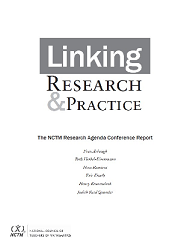As part of its effort to link mathematics education research and practice, NCTM’s Research Committee established the Linking Research and Practice Outstanding Publication Award to recognize work that integrates research and practice and is disseminated to practitioner audiences. Each year one article from each NCTM practitioner journal—Teaching Children Mathematics, Mathematics Teaching in the Middle School, and Mathematics Teacher—will be selected.
Linking Research and Practice Agenda

Several years ago, NCTM launched the Research Agenda Project. From this project, Linking Research and Practice—Challenges and Opportunities, was funded through the National Science Foundation (NSF) (NSF DRL # 0736558). This funding allowed NCTM to organize a small conference of mathematics education researchers and practitioners in order to identify a “research agenda that addresses significant problems of practice and is informed by experiences and expertise of practitioners” (NSF proposal, J. Rubillo, PI).
In August 2008, NCTM brought together approximately 60 mathematics education researchers and practitioners for a 4-day working conference. During this working conference, the participants analyzed over 350 mathematics education practitioner-generated questions in seven areas: assessment, curriculum, equity, student learning, technology, teaching, and teacher preparation/professional development. Their work produced a set of questions that communicate practitioners’ needs for research that would affect their practices.
The result of the working conference was the document, Linking Research and Practice: The NCTM Research Agenda Conference Report (pdf below). The purpose of this document was to:
(a) emphasize the need for communication and collaboration between practitioners and researchers around issues that are important to practitioners;
(b) make practitioners’ research needs, both as initiators and consumers of research, explicit to the mathematics education research community; (c) promote a set of research-guiding questions that focus researchers’ attention on critical problems of practice; and (d) urge funding agencies, policymakers, and other mathematics education stakeholders to support research that is grounded in practitioners’ problems of practice. (Arbaugh et al., 2010)
Linking Research and Practice: The NCTM Research Agenda Conference Report
Linking Research and Practice: Executive Summary
Read other NCTM resources on linking research and practice:
Connecting Research and Practice at NCTM by the NCTM Research Committee (2007)
The Challenge of Linking Research and Practice by the NCTM Research Committee (2006)
What Can We Expect from Research? by James Hiebert (2000)
Mathematics Teacher
Mathematics Teaching in the Middle School
Teaching Children Mathematics
Outstanding Publication Award
Over the past several years, NCTM has increased its effort to link research and practice in mathematics education. As part of that effort, NCTM’s Research Committee created the Linking Research and Practice Outstanding Publication Award to recognize work that integrates research and practice and is disseminated to practitioner audiences. Each year one article from each practitioner journal—Teaching Children Mathematics, Mathematics Teaching in the Middle School, and Mathematics Teacher—will be selected.
Teaching Children Mathematics |

|
| Jonathan N. Thomas and NCTM President Linda Gojak |
Jonathan N. Thomas and Pamela D. Tabor were presented the 2013-2014 Linking Research and Practice Outstanding Publication Award for their article "Developing Quantitative Mental Imagery" published in Teaching Children Mathematics, October 2012. From a series of teaching experiments, the article examines how Stages of Early Arithmetic Learning model how children come to understand quantity, from “physical entity toward more abstract, mental construction of quantity.” The notion of re-presentations is used “to describe how children mentally re-present or re-enact a prior sensory experience to themselves.” Their article offers teachers tools for understanding progression through stages and in helping students “see math with their ‘mind’s eye’ via construction of quantitative mental imagery.’”
Mathematics Teaching in the Middle School |

|
| Kara Jackson and NCTM President Linda Gojak |
Kara J. Jackson, Emily C. Shahan, Lynsey K. Gibbons, and Paul A. Cobb were presented the Linking Research and Practice Outstanding Publication Award for their article "Launching Complex Tasks" published in Mathematics Teaching in the Middle School (August 2012). Their article analyzed videorecordings of 132 middle-grades mathematics teachers to answer the question: How can a teacher launch a complex task so students are able to engage productively with it? “Complex tasks invite students to generate multiple solutions and justify their reasoning. Such tasks live up to their potential only if students engage productively in the task.” The authors support teachers with four critical elements for successfully launching and planning of complex tasks.
Mathematics Teacher |

|
| Heather Lynn Johnson and NCTM President Linda Gojak |
Heather Lynn Johnson was presented the Linking Research and Practice Outstanding Publication Award for her article "Connecting Research to Teaching: Reasoning about Quantities That Change Together" published in Mathematics Teacher (May 2013). In this article, the author draws on interviews with mathematics students to show how they make sense of situations involving quantities that change together. This work stresses the importance of teachers attending to students’ quantitative reasoning involving rates of change. Helping students early on to understand how quantities covary prepares them “to draw on their informal ways of reasoning when the time comes to formalize relationships between varying quantities” in more complex ways, such as in calculus.